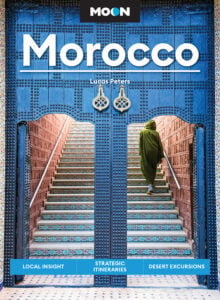While many a tourist and traveler to Tangier spend their time immersed in the medina and navigating the kasbah – if fresh air and flora is your thing, there are some wonderful outdoor spaces to explore. One of these pockets of nature is Donabo Botanical Gardens, located in the forest conservation area of the same name.
The History of The Donabo Gardens
When you are done haggling over that carpet, grab a taxi and head (quite literally) for the hills and Donabo Gardens. Discovering the area known as Jbel Kebir (the big mountain), is an interesting drive in itself that will take you past some beautiful old houses, not to mention a palace or two, and beyond Perdicaris Park to another, newer, botanical gem of Tangier.
The land that has been lovingly transformed into a public garden, Donabo Gardens has been connected to co-founder Lalla Malika Alaoui’s family for over fifty years. Malika’s father was passionate about the forest, and always spoke to his daughter about one specific area with unsurpassed views of the sea across to Spain. In turn Malika shared her fathers love of the land and dreamed of creating a garden for the city of Tangier. Then, call it serendipity, designer Paul Belvoir was in town designing a garden for a friend, conversations took place, dreams were shared and more than five years years later Malika and Paul have finally completed and opened the doors on this botanical labour of love, and the story of Donabo is, we suspect, only starting.

Designing the Donabo Gardens
Before planting could even be considered, the task of clearing needed to start. It took almost a year of shifting rock, removing, and where they could, rescuing trees. Finally the view that had been spoken of so many times by Malika’s father became visible. It was this view, rolling down to the ocean, out and over the straits, which has become the focus and inspiration for the design, built as a series of vistas and interleading paths winding organically though the garden. The creative process that followed was as far as possible, done sympathetically, following the lay of the land and utilizing its natural pattern and form. While rocks had to be cleared, many were kept in place to direct the landscaping and add structure.
During the design process I decided to not do much change to the natural landscape but try to use this idea to divide the land into individual gardens. — Paul Belvoir.

Gardens within Gardens
The gardens are all about a journey – quite literally in some cases with plants collected from around the world by Malika and her family informing the planting. While on another level a walk through the garden is a botanical journey, with ten gardens – each with its own distinctive personality, purpose and scent – housed within the broader garden.
Stepping through the gates you are greeted with a series of raised beds making up the Mediterranean Garden. Alongside that is the entrance to the Chinese Garden, accessed through a traditional Chinese moon gate. The water lilies and lotus flowers immediately transport you to a calmer place.

Crossing continents in a few steps, you enter the Moroccan Garden. Here the planting is, as the name suggests, kept local. Part of the Moroccan garden is the outdoor tea area where you can touch and taste and smell some of the herbs and aromatics used in teas from all over Morocco. The pungent thyme from the Atlas or the Absinth (called shiba in Morocco) also used as an infusion for tea, along with a variety of Moroccan healing herbs, are found here.
Expanding the mint tea metaphor and creating a botanical homage to the quintessential Moroccan beverage, the gardens include a dedicated mint garden. The covered Mint Maze is a sculptural construction that leads you down a very fragrant garden path. Further into the gardens you can sip on teas and juices that are made with the herbs you may have discovered on your way through.

The journey continues through a Rose Garden, into Pollinator Gardens, before you step into a space dedicated to chillis and another to vegetables. Wind your way through a vineyard, discover a quiet place to contemplate life, step down into the forest and listen out for the birds and the bees. Gardens within gardens, and curated pockets contained within the confines of the overall structure all work together to create a sense of space. Finally, after taking a quick whiff of the roses, take a seat at the organic restaurant. The restaurant was built out of the rock excavated from the garden to create a series of terraces with more of those stunning views over the Mediterranean Sea.
Visiting the Donabo Gardens
With its name originating from the Latin verb donare, which means to give, this garden is all about generosity. The connective threads that run through it – from its design to its purpose – are about community. It is about creating something to share. It is about space, scents, and knowledge. Ultimately about sharing a passion for the plants and vistas of Tangier. For you, it is a generous invitation to see and experience something that makes the locals of Tangier proud to call this corner of Africa home.
The gardens are also a lovely space for children! The generosity extends into our future generations. It is a real hope for the team at Donabo Gardens to teach our youngest and cultivate their knowledge about the plants and nature. So, put this at the top of your list for family travel to Morocco!
For more information about the Donabo Botanical Gardens, visit their website (https://www.donabogardens.com) or contact the team at Journey Beyond Travel.
Other Fantastic Gardens in Morocco
It may come as a surprise, but Morocco is a bit of garden lovers dream! There are many gardens to discover, from Tangier all the way to Marrakesh and beyond! Here are a few of our other favorites (click on the garden name to read more):
- Tangier: Perdicaris Park
- Marrakesh: The Secret Garden
- Marrakesh: Majorelle Garden
About the Author
 Pauline de Villiers Brettell is a freelance writer and designer who lives between the UK and Morocco. When in Morocco she is based in the small seaside village of Asilah, and spends time working with local weavers and sourcing textiles in between attempting to grow enough olives for an annual supply of olive oil! She writes about all of these things — the olives, the carpets, and other elements of design inspiration — on her blog Tea in Tangier: www.teaintangier.com.
Pauline de Villiers Brettell is a freelance writer and designer who lives between the UK and Morocco. When in Morocco she is based in the small seaside village of Asilah, and spends time working with local weavers and sourcing textiles in between attempting to grow enough olives for an annual supply of olive oil! She writes about all of these things — the olives, the carpets, and other elements of design inspiration — on her blog Tea in Tangier: www.teaintangier.com.
Photos by Lucas Peters. Lucas is the principal photographer and author of the Moon Guidebooks: Morocco as well as Marrakesh and Beyond published by Hachette. He edited and contributed to the Our Morocco anthology and helps the travelers of Journey Beyond Travel experience the adventure of a lifetime. He lives in Tangier with his family.









